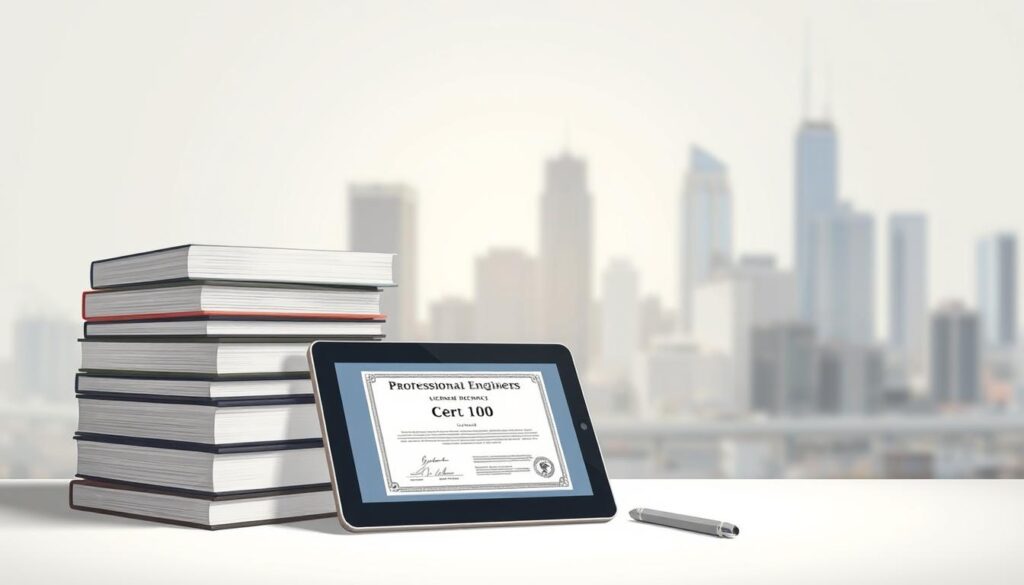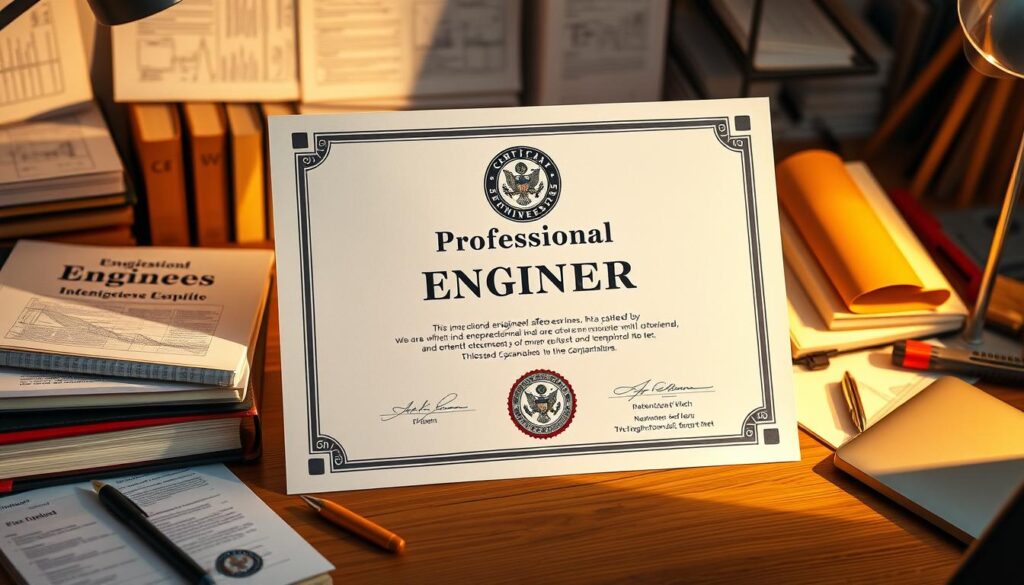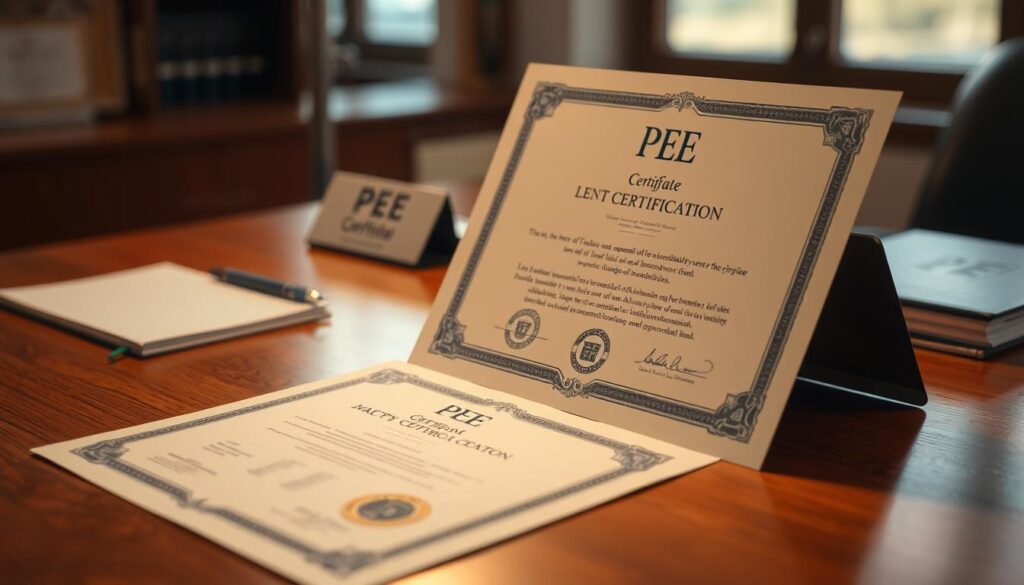Becoming a licensed Professional Engineer (PE) in the USA is a significant career milestone that requires a combination of education, experience, and passing a licensing exam. But what does it take to achieve this prestigious certification?
Earning a PE license is a mark of excellence in the engineering field, demonstrating expertise and a commitment to public safety. In this article, we will guide you through the steps to achieve your PE certification, from understanding the role of a professional engineer to the final licensing process.
Key Takeaways
- Understand the importance of PE certification in the USA
- Learn the educational requirements for becoming a licensed Professional Engineer
- Discover the steps involved in the licensing process
- Gain insights into the benefits of achieving PE certification
- Find out how to prepare for the licensing exam
Understanding the Role of a Professional Engineer
In the United States, the process of becoming a licensed professional engineer is rigorous, designed to ensure that engineers possess both the theoretical foundations and practical skills necessary for their profession. This licensure is not just a formality; it is a critical validation of an engineer’s ability to provide safe and effective solutions.
What is a Licensed Professional Engineer?
A licensed professional engineer is an individual who has met the necessary qualifications and has been licensed by a state to practice engineering. This involves having completed a rigorous educational program, gained significant practical experience, and passed two demanding exams: the Fundamentals of Engineering (FE) exam and the Principles and Practice of Engineering (PE) exam.
The licensure signifies that the engineer has demonstrated a high level of competence in their field, adhering to the highest standards of practice. It is a mark of excellence that distinguishes professional engineers from others in the field.
Importance of Licensing in Engineering
Licensing in engineering is crucial for several reasons. Firstly, it ensures that engineers are qualified to perform their duties, safeguarding public health, safety, and welfare. Secondly, it promotes a level of professionalism and ethics within the engineering community. Licensed engineers are expected to adhere to a code of ethics and continue their education to stay updated with the latest developments in their field.
Key benefits of licensing include:
- Enhanced credibility and recognition within the profession
- Increased career opportunities and higher earning potential
- A demonstrated commitment to public safety and welfare
- Adherence to a strict code of ethics and professional standards
Educational Requirements for Aspiring Engineers
A bachelor’s degree in engineering is the first step towards a career as a licensed professional engineer. This foundational education provides the necessary knowledge and skills required for the profession.
Bachelor’s Degree in Engineering
To become a licensed professional engineer, one must start by earning a bachelor’s degree from an engineering program that is accredited by the Accreditation Board for Engineering and Technology (ABET). ABET accreditation is crucial as it ensures that the program meets the quality standards and educational requirements necessary for a career in engineering.
The coursework in an ABET-accredited program covers a broad range of topics relevant to the field of engineering, including mathematics, physics, and engineering sciences. This comprehensive education prepares students for the challenges they will face in their professional careers.
Accreditation from ABET
Accreditation from ABET is not just a formality; it is a mark of excellence that signifies the program’s commitment to providing high-quality education. Programs that are accredited by ABET have undergone a rigorous review process to ensure they meet the standards set by the engineering community.
| Accreditation Status | Description | Importance |
|---|---|---|
| ABET Accredited | Programs that have met the rigorous standards set by ABET | Ensures quality education and eligibility for licensure |
| Non-Accredited | Programs that have not been accredited by ABET | May not meet the necessary standards for licensure |
As noted by the National Council of Examiners for Engineering and Surveying (NCEES), “Graduation from an ABET-accredited program is an essential step in the licensure process.” This underscores the importance of choosing an accredited program for aspiring engineers.
“The accreditation process ensures that programs are providing students with the knowledge, skills, and attitudes necessary to become licensed professional engineers.”

In conclusion, fulfilling the educational requirements is a critical step towards becoming a licensed professional engineer. By obtaining a bachelor’s degree from an ABET-accredited program, aspiring engineers can ensure they are well-prepared for the licensure process and their future careers.
Pre-Licensing Work Experience
The path to obtaining a PE license involves significant pre-licensing work experience under the supervision of a licensed engineer. This experience is crucial for developing the skills and judgment necessary for independent practice as a Professional Engineer.
Importance of Gaining Practical Experience
Gaining practical experience is a vital component of the PE license process. Most states require aspiring engineers to work under the supervision of a licensed Professional Engineer before they can take the Principles and Practice of Engineering (PE) exam. This hands-on experience helps engineers apply theoretical knowledge to real-world problems, enhancing their understanding and capabilities.
During this period, aspiring engineers can expect to be involved in various projects, gaining exposure to different aspects of engineering. This diversity is essential for developing a comprehensive understanding of engineering practices and principles.
Transitioning from Engineer-in-Training (EIT) to P.E.
The transition from Engineer-in-Training (EIT) to a licensed Professional Engineer (P.E.) involves not just passing the PE exam but also accumulating sufficient work experience. This experience is critical for demonstrating competence and readiness for independent practice.
The following table outlines the typical requirements for transitioning from EIT to P.E.:
| Requirement | Description | Typical Duration |
|---|---|---|
| Supervised Work Experience | Working under the supervision of a licensed P.E. | 4-8 years |
| Principles and Practice of Engineering (PE) Exam | Passing the PE exam in the relevant engineering discipline | Varies |
| State Licensure | Obtaining licensure from the state engineering board | Varies |
By understanding these requirements and focusing on gaining practical experience, aspiring engineers can successfully navigate the engineering licensure exam process and achieve their goal of becoming a licensed Professional Engineer.
Fundamentals of Engineering (FE) Exam
The Fundamentals of Engineering (FE) exam is a critical milestone in an engineer’s path to licensure. It is designed to test the knowledge, skills, and abilities of engineering graduates and those who are early in their engineering careers.
Overview of the FE Exam
The FE exam is typically taken by recent graduates or those who are in the early stages of their engineering careers. It covers a broad range of engineering fundamentals, including mathematics, science, and engineering principles. The exam is usually administered by the National Council of Examiners for Engineering and Surveying (NCEES).
Exam Format: The FE exam is a computer-based test that includes multiple-choice questions. The specific format and content can vary depending on the engineering discipline.

Preparation Resources for the FE Exam
Preparation is key to passing the FE exam. There are numerous resources available to help candidates prepare, including:
- Study guides and review manuals specific to the engineering discipline
- Online review courses and practice exams
- Sample questions and practice problems
According to the NCEES, “Effective preparation is the key to passing the FE exam.”
“The best way to prepare is to use a combination of study materials and practice exams to assess your knowledge and identify areas for improvement.”
| Resource Type | Description | Benefit |
|---|---|---|
| Study Guides | Comprehensive review of engineering principles | Helps in understanding key concepts |
| Online Courses | Interactive learning with practice problems | Enhances problem-solving skills |
| Practice Exams | Simulates the actual exam experience | Reduces exam anxiety and improves time management |
By utilizing these resources and understanding the engineer licensure requirements, aspiring engineers can better prepare themselves for the FE exam and move closer to achieving PE certification.
Principles and Practice of Engineering (PE) Exam
The PE exam represents the final hurdle in the licensure process for aspiring Professional Engineers, testing their ability to apply engineering principles in real-world scenarios. It is a critical assessment that evaluates an engineer’s knowledge, skills, and ability to practice engineering safely and competently.
What to Expect from the PE Exam
The PE exam is designed to assess the engineer’s ability to apply their knowledge and skills in a practical manner. It typically consists of multiple-choice questions and/or problems that require the application of engineering principles to solve. The exam format and content may vary depending on the engineering discipline.
Key aspects of the PE exam include:
- Discipline-specific content that tests the engineer’s expertise in their chosen field.
- Practical problems that require the application of theoretical knowledge.
- Time management is crucial as the exam is typically timed.
Study Strategies for Success
To succeed in the PE exam, a structured study plan is essential. This includes reviewing relevant materials, practicing with sample questions, and participating in study groups or review courses. Effective study strategies can significantly enhance a candidate’s chances of passing the exam.
Some effective study strategies include:
- Creating a study schedule that allows for comprehensive review of all relevant material.
- Utilizing practice exams and sample questions to assess knowledge and identify areas for improvement.
- Joining a study group or review course to collaborate with peers and gain insights from experienced instructors.
By understanding what to expect from the PE exam and employing effective study strategies, engineers can better prepare themselves for the challenges of the licensure process. Achieving a passing score on the PE exam is a significant milestone on the path to becoming a licensed Professional Engineer.
Licensing Process Overview
The journey to becoming a licensed Professional Engineer in the USA involves a multi-step process that ensures aspiring engineers meet the required standards of competence and integrity. This process is designed to verify that engineers have the necessary educational background, technical knowledge, and practical experience to perform their professional duties effectively.

Steps to Achieving Your P.E. License
Aspiring Professional Engineers must follow a series of steps to achieve licensure. First, they must earn a bachelor’s degree from an Accreditation Board for Engineering and Technology (ABET)-accredited program, which provides a solid foundation in engineering principles. Next, they need to pass the Fundamentals of Engineering (FE) exam, which tests their knowledge of engineering fundamentals. After gaining relevant work experience, typically under the supervision of a licensed Professional Engineer, they can then sit for the Principles and Practice of Engineering (PE) exam, which assesses their ability to apply engineering principles to real-world problems.
Fees Involved in the Licensing Process
The licensing process involves various fees, including application fees, examination fees for the FE and PE exams, and licensure fees. These costs can vary by state, so it’s essential for applicants to check with their state’s engineering licensing board for specific fee schedules. Understanding these costs upfront helps engineers plan their licensure journey more effectively.
State-Specific Licensing Requirements
The journey to becoming a licensed Professional Engineer involves navigating state-specific licensing requirements. While the overall process shares commonalities across the United States, each state has its unique set of rules and regulations governing the licensure of professional engineers.
Understanding Variations by State
Licensing requirements for engineers are not one-size-fits-all; they vary significantly from one state to another. These variations can include differences in educational requirements, engineer licensure requirements, examination processes, and continuing education needs. For instance, some states may have specific requirements for the number of hours of professional practice or different formats for the PE certification exam.
Checking Requirements on State Engineering Boards
Aspiring engineers must check with their state’s engineering board to understand the specific licensure requirements. State engineering boards are responsible for overseeing the licensure process, and they provide detailed information on their websites about the necessary steps, required documentation, and associated fees. It’s essential to visit these websites regularly, as requirements can change.
To ensure compliance with state regulations, it’s also beneficial to review the National Council of Examiners for Engineering and Surveying (NCEES) guidelines, as many state boards follow NCEES standards for PE certification. By understanding and adhering to these state-specific requirements, engineers can successfully navigate the licensure process.
Professional Development and Continuing Education
To maintain their licensure and stay relevant, professional engineers must commit to lifelong learning. This commitment not only enhances their skills and knowledge but also ensures they remain compliant with state regulations.
Continuing education is a critical aspect of a professional engineer’s career. It involves staying updated with the latest technologies, methodologies, and industry standards. Most states require licensed engineers to complete continuing education requirements to renew their licenses.
Importance of Lifelong Learning
Lifelong learning is essential for engineers to stay current in their field. It allows them to adapt to new technologies and methodologies, ensuring they remain competent and competitive. Moreover, it fosters innovation and improvement in their practice.
Some key benefits of lifelong learning include:
- Enhanced professional competence
- Improved job prospects
- Greater ability to adapt to industry changes
- Increased innovation in their work
Continuing Education Requirements for P.E. License Renewal
Continuing education requirements vary by state, but most require a certain number of professional development hours (PDHs) or continuing education units (CEUs) within a specified renewal period. Engineers must comply with these requirements to maintain their licensure.
| State | Required PDHs/CEUs | Renewal Period |
|---|---|---|
| California | 30 hours | 2 years |
| Texas | 30 hours | 2 years |
| New York | 36 hours | 3 years |
Engineers should check with their state’s engineering board for specific requirements.

By prioritizing continuing education, professional engineers can ensure they remain at the forefront of their field, contributing to their ongoing success and the advancement of the engineering profession as a whole.
Ethical and Professional Responsibilities
The path to becoming a licensed professional engineer involves not just technical knowledge, but also a deep understanding of ethical and professional responsibilities. As engineers progress in their careers, they must adhere to a strict code of ethics that ensures their work is conducted with integrity, honesty, and fairness.
Understanding the Engineer’s Code of Ethics
The Engineer’s Code of Ethics serves as a guide for professional engineers, outlining the ethical standards they must uphold. This code is designed to protect the public’s health, safety, and welfare, and it encompasses principles such as avoiding conflicts of interest, maintaining confidentiality, and being honest in their professional dealings.
For instance, the National Society of Professional Engineers (NSPE) provides a comprehensive code of ethics that serves as a model for state licensing boards. This code emphasizes the importance of ethical decision-making and encourages engineers to consider the broader implications of their work.
Importance of Professional Responsibility
Professional responsibility is a cornerstone of the engineering profession. It involves not only complying with legal and ethical standards but also taking responsibility for one’s work and its impact on society. Engineers must be accountable for their designs, decisions, and actions, recognizing that their professional judgments can have significant consequences.
By embracing their professional responsibilities, engineers can build trust with their clients, colleagues, and the public. This trust is essential for the successful execution of engineering projects and for maintaining the integrity of the profession as a whole.
Key aspects of professional responsibility include:
- Maintaining and improving professional competence
- Being honest and impartial in their work
- Respecting the rights and dignity of all individuals
- Continuously updating their knowledge and skills to reflect advancements in their field
By upholding these principles, licensed professional engineers can ensure that their work contributes positively to society, aligning with the highest standards of their profession.
Networking and Professional Organizations
The journey to becoming a licensed professional engineer involves not just education and exams, but also building a professional network. As engineers progress in their careers, the importance of networking and being part of professional organizations becomes increasingly evident.
Joining engineering societies can open up numerous opportunities for career advancement. These organizations provide a platform for networking, professional development, and staying updated on industry trends. Some of the key benefits include:
- Access to conferences and seminars where engineers can learn about the latest developments in their field.
- Opportunities to connect with experienced professionals who can offer guidance and mentorship.
- Participation in committees and working groups that shape the future of engineering practices.
Benefits of Joining Engineering Societies
Engineering societies, such as the National Society of Professional Engineers (NSPE), offer a range of benefits for members. These include:
- Professional development resources, including webinars and training programs.
- Networking events that facilitate connections with other professionals in the field.
- Advocacy on issues related to engineering licensure and practice.

Finding Mentorship Opportunities
Finding a mentor who is a licensed professional engineer can be incredibly valuable. Mentors can provide guidance on navigating engineer licensure requirements and offer insights into the profession. To find a mentor, consider:
- Reaching out to professional societies for mentorship programs.
- Attending industry events and conferences.
- Connecting with experienced engineers through online platforms like LinkedIn.
By engaging with professional organizations and finding mentorship opportunities, engineers can enhance their careers and stay informed about the latest developments in their field, including PE certification processes.
Job Market for Licensed Professional Engineers
Licensed professional engineers are sought after across various industries, thanks to their expertise and the value they bring to complex projects. The professional engineering license is a mark of excellence, indicating that an engineer has met rigorous standards of competence.
Current Demand for P.E.s in the Workforce
The demand for licensed professional engineers is driven by ongoing infrastructure projects, technological advancements, and the need for innovative solutions to complex problems. As a result, P.E.s are finding opportunities in a wide range of fields, from traditional construction and manufacturing to emerging areas like renewable energy and cybersecurity.
According to industry trends, the employment of civil engineers, including those with a P.E. license, is projected to grow due to the need for infrastructure repair and development. Moreover, the increasing complexity of engineering projects requires the expertise of licensed professionals who can oversee and validate the work.
Industries that Value P.E. Certification
Several industries place a high value on the PE license process and the certification it provides. These include:
- Construction: Ensuring that projects are executed safely and to code.
- Manufacturing: Overseeing production processes and ensuring compliance with regulations.
- Government: Working on public infrastructure projects and policy-making.
- Energy: Developing and implementing sustainable energy solutions.
In these industries, having a professional engineering license not only enhances job prospects but also opens up opportunities for career advancement and leadership roles.
Advancing Your Engineering Career
As a licensed professional engineer, you are poised to take your career to new heights. With your licensure, you have demonstrated expertise and a commitment to your field, positioning you for further growth and opportunities.

Opportunities for Leadership Roles
Licensure often serves as a prerequisite for leadership positions within engineering firms and organizations. As a licensed professional engineer, you become eligible for senior roles that involve managing projects, leading teams, and making strategic decisions. These leadership opportunities not only bring greater challenges but also offer the potential for increased compensation and professional satisfaction.
To capitalize on these opportunities, focus on developing your management and leadership skills. This can involve pursuing additional education or certifications, such as an MBA or project management credentials. Networking within professional organizations and participating in industry conferences can also help you stay informed about emerging trends and best practices in engineering leadership.
Diversifying Your Skills and Specializations
Diversifying your skills and specializations is another effective way to advance your engineering career. The field of engineering is constantly evolving, with new technologies and methodologies being introduced regularly. By expanding your skill set, you can remain relevant and competitive in the job market.
- Pursue specialized certifications or training in emerging areas such as sustainable engineering, data analytics, or digital manufacturing.
- Explore interdisciplinary collaborations that combine engineering with other fields, such as environmental science or computer science.
- Consider obtaining a graduate degree if you’re interested in highly specialized areas or academia.
By diversifying your skills and embracing new challenges, you can enhance your career prospects and contribute to innovative projects that shape the future of engineering.
Preparing for a Licensing Interview
A well-prepared candidate is more likely to make a strong impression during the licensing interview. As you prepare, it’s crucial to understand the types of questions you’ll be asked and how to showcase your skills and experience effectively.
Common Questions to Expect
During a licensing interview, you can expect questions that assess your technical knowledge, problem-solving skills, and professional experience. Some common areas of inquiry include your understanding of engineering principles, your experience with projects, and your ability to apply theoretical knowledge to practical problems.
Examples of common questions:
- Can you describe a challenging project you worked on and how you overcame any obstacles?
- How do you stay current with developments in your field?
- What do you believe are the most important ethical considerations for a professional engineer?
Tips for Making a Strong Impression
Making a strong impression during your licensing interview involves more than just answering questions correctly. It’s about demonstrating your professionalism, confidence, and passion for engineering.
Here are some tips to help you succeed:
- Be prepared to discuss your experience: Review your projects and be ready to talk about your role, the challenges you faced, and how you contributed to the outcome.
- Show enthusiasm and interest: Demonstrate your passion for engineering and your commitment to your profession.
- Practice your responses: Anticipate common questions and practice your responses to ensure you can articulate your thoughts clearly and confidently.
“The way to get started is to quit talking and begin doing.” – Walt Disney
This quote emphasizes the importance of preparation and action. By being well-prepared for your licensing interview, you can make a positive impression and take a significant step towards achieving your PE certification.
Resources for Aspiring Engineers
Engineers on the path to licensure can tap into a rich pool of resources, including books, guides, and online forums. These resources are designed to support aspiring engineers through the licensure process, providing valuable insights and study materials.

Books and Guides on Engineering Licensure
A variety of study materials are available for engineers preparing for the licensure exams. These include comprehensive textbooks, practice exams, and study guides tailored to the Fundamentals of Engineering (FE) and Principles and Practice of Engineering (PE) exams.
Some recommended texts offer detailed explanations of key concepts, along with sample questions and solutions. Utilizing these resources can significantly enhance an engineer’s understanding and readiness for the exams.
Online Communities and Forums
Beyond traditional study materials, online communities and forums provide a platform for aspiring engineers to connect, share resources, and seek advice from experienced professionals. These communities can be invaluable for staying motivated and informed throughout the licensure process.
“Joining a professional community can make a significant difference in your journey to becoming a licensed engineer. It’s not just about the resources; it’s about the connections and the support you receive along the way.”
Engaging with these online platforms can also offer insights into best practices and new developments in the field, further enriching an engineer’s professional development.
Conclusion: The Path to Becoming a P.E.
Becoming a licensed professional engineer is a significant achievement that requires dedication and perseverance. The journey involves several key steps, including obtaining the right education, gaining practical experience, and passing the necessary exams.
Key Considerations for Aspiring Engineers
Aspiring engineers must understand the importance of accreditation from organizations like ABET and the need to pass both the Fundamentals of Engineering (FE) and Principles and Practice of Engineering (PE) exams. State-specific licensing requirements also play a crucial role in the process.
Moving Forward with Your P.E. License
Once you’ve obtained your professional engineering license, you’ll be well-positioned to advance your career and take on leadership roles. Continuing education and staying updated with industry developments are essential for long-term success. By following the steps to become a licensed engineer, you’ll be able to enhance your career prospects and contribute to the field of engineering.
Pursuing a professional engineering license is a rewarding career milestone. With the right guidance and resources, you can navigate the licensing process and achieve your goals.
